In July 1967, the Nigerian Civil War brought unspeakable violence into our living rooms; the sights and sounds of conflict were transmitted directly to our television sets. As a result of the conflict, civilians were killed, and a blockade led to the mass starvation of the Nigerian people.
Every night a 10-year-old Pat Laberge would be glued to the television screen as her parents watched the news about the breakaway state of Biafra’s attempt to split from Nigeria. Sitting on the floor with her back up against the couch, she would witness the worst of humanity but also, as it turned out, some of the best.
“I just remember night after night for what seemed like weeks this was always a news item, this war in Biafra. The fighting, the starving children, the displaced people,” Pat says. “I also remember the Red Cross and that the Red Cross was helping.”
It wasn’t long before she pointed at the television and blurted out that this was what she wanted to do with her life. She was going to be a humanitarian. She was going to join the Red Cross. And she did.
It’s a good story, one she’s told many times before. There’s truth to the idea that watching those horrific events unfold on television shaped the life she would choose to pursue, but that’s not what made Pat a humanitarian.
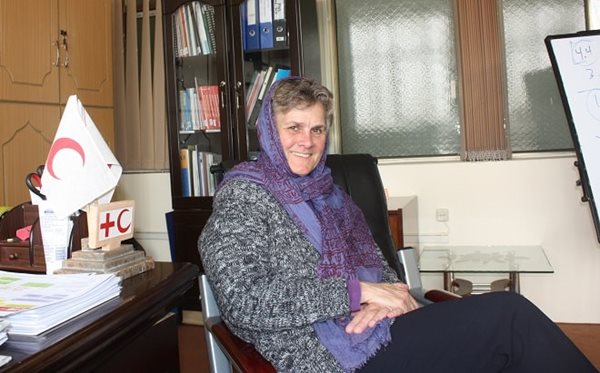 Pat, as Head of IFRC Delegation in Afghanistan in 2015.
Pat, as Head of IFRC Delegation in Afghanistan in 2015.
Pat grew up in the northern Ontario community of Kapuskasing with her five siblings, tearing around on snowmobiles or minibikes through the three kilometres of fields that separated their property from the airport, where her father was the manager.
“We all had bicycles and my dad said, ‘I’m not changing a flat tire every evening.’ So, he took us all to the garage and he taught us how to change a flat tire on a bike,” Pat shares. “My mother said, ‘I am not ironing everybody’s clothes.’ So, she taught everybody how to iron, sew buttons and hem pants. The boys and the girls. There was no distinction.”
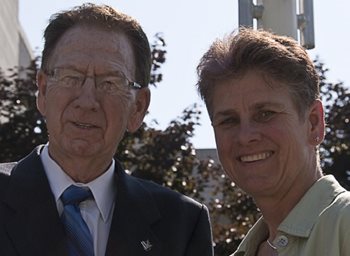
Pat often spent time in the airport garage listening to her father (pictured here with Pat on the right) patiently explain the ins and outs of mechanics while he tinkered away on his latest project.
“He took pride in teaching me,” says Pat. “He taught me the different names of tools so when he’s under the car and says, ‘I need this ratchet,’ or ‘I need this wrench,’ I knew exactly what he was talking about. He would teach me these things and I loved it.”
Her father had a tough upbringing, and he became convinced that this was not the way people should be treated. He would show people kindness and respect - values he made sure to instill in his children.
There were no Red Cross branches in northern Ontario when Pat graduated from university, so she decided to pursue the international part of her childhood dream first. However, she was not ready to parachute into a conflict zone. Instead, she signed up with the World University Service of Canada to teach in Botswana where she ended up working as a teacher.
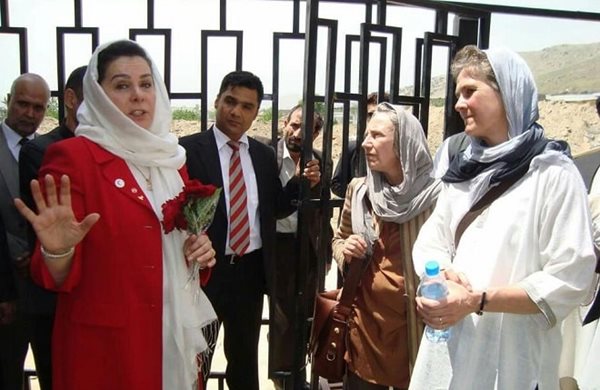 Fatima Gailani, President of Afghan Red Crescent, ICRC Head of Delegation and Pat during a visit to ARCS shelter for women in 2015.
Fatima Gailani, President of Afghan Red Crescent, ICRC Head of Delegation and Pat during a visit to ARCS shelter for women in 2015.
“There were only three expats in a school of 15 teachers. We weren’t in charge. We were just like anybody else. It just made absolute sense to me,” Pat explains. “It was afterwards that I realized this isn’t how things get done in other countries. In other countries it seems like they give up their sovereignty. But in Botswana that wasn’t the case. I kept that idea with me in all my work afterwards. The country is sovereign. The local Red Cross Society is sovereign.”
Back in Canada, Pat refused to give up her dream of working for the Red Cross. After a few more years of teaching and working in Northern communities, it finally happened. Pat joined the Canadian Red Cross as a blood donor recruiter. Bringing in donors for the plasma program as a member of the (now former) Blood Donation program was perhaps not what her 10-year-old self had imagined, but nevertheless Pat loved the job. Her first day of work was March 9, 1994. A month later, the genocide in Rwanda began.
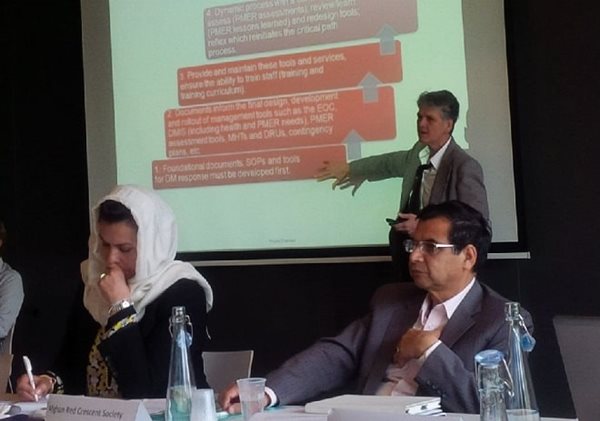 Presenting the joint Afghan Red Crescent/Canadian Red Cross Disaster Management Capacity Building Program at the ICRC Round table on Afghanistan in Geneva.
Presenting the joint Afghan Red Crescent/Canadian Red Cross Disaster Management Capacity Building Program at the ICRC Round table on Afghanistan in Geneva.
By June, the International Committee of the Red Cross was scaling up its operations in Rwanda and looking for French-speaking people with experience working in Africa. Pat raised her hand.
“That was my first Red Cross mission. It was life changing. You drove into a village that was deserted and you could smell the rotting bodies,” Pat remembers. “The graves were very shallow, so very often you would see a dog with a human bone. The horror still hung in the air.”
As ethnic violence between the Hutus and Tutsis overtook the country, no one was thinking about that year’s harvest. Neglected, the crops rotted, and plunged the region into yet another crisis: famine. When Pat arrived, the violence had subsided, and she was tasked with organizing food distribution. But remnants of the conflict remained.
As the team was distributing food one day, a man stepped on a landmine that had been left buried in the ground. He lost his foot immediately, but Pat, reacting quickly, may have saved his life by driving him to the hospital. It was moments like these that solidified that this was what she was meant to do.
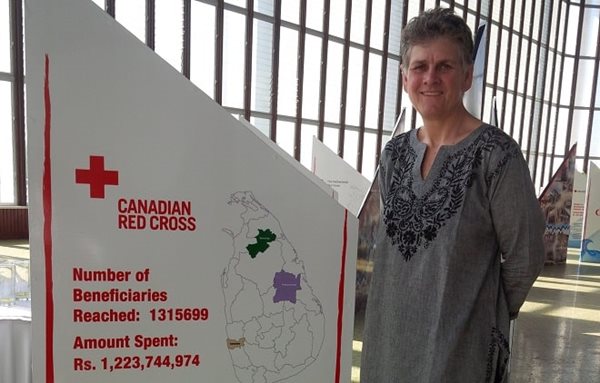 At the 10th anniversary of the Indian Ocean Tsunami conference hosted by the Sri Lanka Red Cross in 2014.
At the 10th anniversary of the Indian Ocean Tsunami conference hosted by the Sri Lanka Red Cross in 2014.
Two years later, in 1996, Pat was working in International Operations at the Canadian Red Cross, intent on infusing the organization with the lessons she had learned in Botswana and Rwanda.
“I brought with me the philosophy of supporting the capacity of the National Society,” says Pat. “As my role elevated in the organization, I decided I would ensure that whatever we do, it always supports the people on the ground.”
That effort to build, rather than replace started with a trip to China. Donors from the Chinese diaspora in Canada were looking for ways to regularly give back to their home country. Pat decided the best way to do that would be by building a relationship with the Red Cross Society of China directly.
“We’ve been partners ever since, so we’re talking a 23-year relationship,” Pat says. “Over the years there was a real openness to learning, adapting, and incorporating the technical advice, but also turning it into what was logical for them. So, there’s an equal relationship here.”
A glib refrain in the humanitarian world is that the goal is to work yourself out of a job, but few truly relish that prospect. So, when Pat began advocating for building local capacity, she immediately had people pushing back on that idea. They saw stepping back as a reduction in power. But really it was about working yourself out of the job of being in charge and discovering that when you act in partnership, there will always be work that can be shared.
“When we started looking beyond relief and started developing programs with [Red Cross and Red Crescent] National Societies, that really gave us the opportunity to build up relationships, understanding, and trust,” explains Yunhong Zhang, Program Manager for International Operations at the Canadian Red Cross. “That’s what eventually allowed us to really build local capacity.”
This was by no means the end of the push to rethink how the Red Cross approaches its humanitarian work, but it did show that Pat did not need to — and in fact would not — abandon her principles to achieve that goal.
“She’s a bit like a terrier when she has a good idea. She doesn’t give up easily. She’s really motivated by all the right things,” says Patti Strong, Director of International Partnerships and Pat's long-time friend and colleague. “The strengthening of National Societies is a good example. Pat and I were committed to that, even though it was thought of as a waste of time and not the way we should be going. Now it’s our primary focus. It’s defining who we are.”
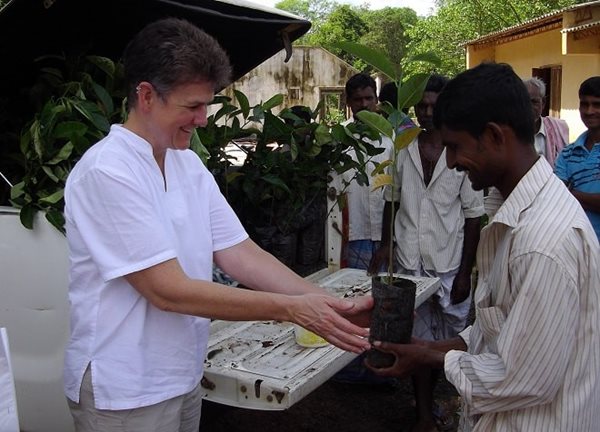 Pat distributing fruit tree seedlings to recipients of Canadian Red Cross constructed houses in Sri Lanka.
Pat distributing fruit tree seedlings to recipients of Canadian Red Cross constructed houses in Sri Lanka.
“I think someone like Pat gets their oxygen from two places. Going back to the principles and the ideals of the Red Cross Movement. You can look at these ideals and decide you want to dedicate your professional life to them,” comments Stéphane Michaud, Vice President of International Operations. “Then you can go in the communities and see where the Red Cross is having an impact, really changing people’s lives like in South Sudan and Afghanistan.”
For Pat, these values are embodied in the volunteer. That is who she thinks about in moments of self-doubt.
“They’re there because they care about their community,” Pat explains. “So, regardless of the failures and the flaws — because all organizations have flaws — the core of our work is to ensure that these people are able to do what they need to do in their community. That was my guiding force.”
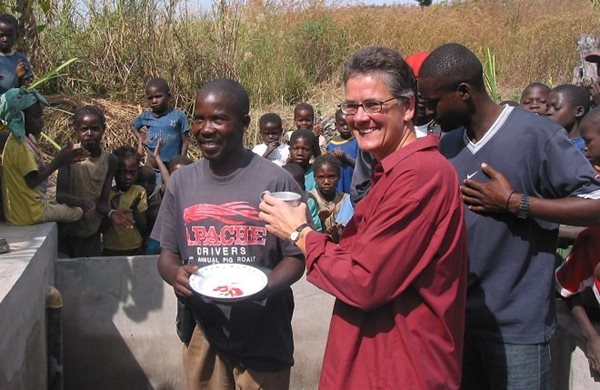 Inauguration of a community water site rehabilitated by ICRC and Angolan Red Cross in 2001.
Inauguration of a community water site rehabilitated by ICRC and Angolan Red Cross in 2001.
When asked to speak at her retirement party this past November, Pat didn’t know what to say. Much like how a professional athlete struggles when pressed to explain their ability to accomplish remarkable feats of strength or endurance, she insists that she’s not doing anything special.
“I’m not deliberately trying to be a role model. I’m just kind of being myself,” Pat remarks. “If it has an impact on people, if it has a ripple effect and people think of doing things differently, then that’s great.”
But just like an athlete, she has reached these heights through some mix of natural ability, relentless training, and unrestrained joy in what she does. And despite her modesty, Pat has had a profound impact on the lives of the people she’s worked with and the Red Cross itself.
Pat is, as Yunhong describes her, a humanitarian warrior. An oxymoron that somehow - just - manages to capture the essence of a woman who has dedicated her life to fighting for what she knows is right. Not for herself, but for everyone else. She has shone a light in the darkness and illuminated what it means to truly be a humanitarian. That is her legacy.
Related stories:

